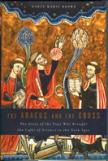The Student Pope
It is perhaps a commonplace that travelers should expect to examine and reinterpret their native notions when on a journey—the language, the conceptual vocabulary, the customary hometown currencies must be exchanged for other coin in other marketplaces. Similar shifts can take place when traversing the history of a less-than-familiar age. Touring the late 10th century via Nancy Marie Brown’s masterful recounting of the life and times of Gerbert of Aurillac, the French monk who became Pope Sylvester II, requires an intellectual Baedeker of sorts, one that Brown aptly and affably provides. Even the book’s title and subtitle require a bit of verbal reorientation, as an early medieval abacus and ninth-century science do not map readily onto contemporary notions of those entities. But a large measure of what makes this book intriguing is precisely these and other bits of connotative dissonance that Brown deftly elucidates and resolves throughout.
Gerbert is the axis around which her narrative revolves; she unwinds the track of his life thoughtfully, with a scholar’s care to avoid overstatement or drawing unsupported conclusions. The future pope is revealed as a lifelong student, an avid bookman, an innovative teacher and textbook writer and an inquisitive and passionate investigator. Brown notes that Gerbert was the first Christian teacher of arithmetic to employ Arabic numerals in the classroom and was skilled in the use of the astrolabe and other instruments of astronomical observation.
It is not until later in the story that what could be called Gerbert’s spiritual motivation comes to light. His passion for understanding the order of the universe, whether revealed in the intricate and intellectually satisfying connections of arithmetic and geometry, in the harmonies of stretched strings and windblown pipes or in the celestial mechanisms of fixed star and wandering planet—all these orders, for Gerbert, were ways to illuminate the mysteries of the Cosmic Orderer. This may seem to modern eyes to be a dry field to till, but for this monastic scholar, it was a fertile plot for “contemplating, admiring, and praising the wondrous meaning of nature and the wisdom of its Creator.”
As Gerbert’s story careers toward Rome, his gifts as teacher and man of letters do not serve him particularly well. Here again, Brown brings to light a sense of the seat of Christendom perhaps alien to contemporary readers, one more connected to statecraft, empire and political machination, with the papacy “just one more center of power,” less linked to current notions of moral, theological or spiritual leadership. Through his connections with the Holy Roman Emperor Otto III, who sought to restore the Roman Empire, Gerbert was elected Pope Sylvester II, the first French pope, in the year 999. Neither Otto nor Gerbert flourished long thereafter; Otto died three years later, at the age of 22, and Gerbert died within a year of Otto’s passing. With Gerbert’s death, according to Brown, a world ended, one in which “Muslims, Christians, and Jews could sit down together and translate works of science from Arabic and Greek into Latin; the world in which a peasant boy who had excelled in such science could end up as pope.” Scholarship, then as now, is subject to buffeting by the winds of political change.
Brown carries her scholarship lightly and provides diverting glimpses into the monastery scriptorium, paper manufactory and refectory along the way. Misconceptions regarding other medievalia are debunked as well: the earth was not commonly thought to be flat; Christianity was not always at war with Islam; science was not at loggerheads with theology; there was no widespread “Terror of the Year 1000.” With the caveat that such terms as science, astronomy and experiment need some reinterpretation when Brown employs them in reference to Gerbert’s activities, her point is not badly made. It may be argued that Gerbert’s natural philosophy directs itself differently when compared to that developed several centuries later by Galileo, Descartes and Newton—but then, finding in Gerbert’s Cosmic Orderer the God of Abraham, Isaac and Jacob requires a shift of the intellectual compass as well.
The Abacus and the Cross provides at once an engaging encounter with a figure of interest and influence, and a way to see the issues Gerbert confronts as having modern parallels. A grand tour, indeed.
This article also appeared in print, under the headline “The Student Pope,” in the May 2, 2011, issue.








